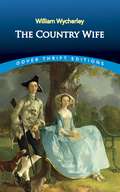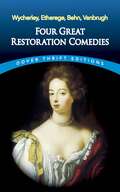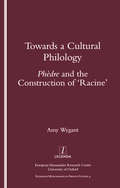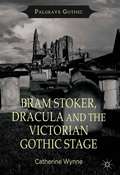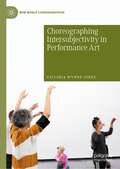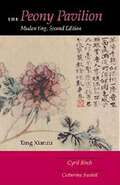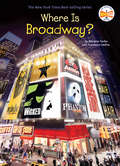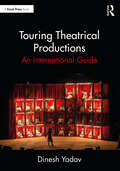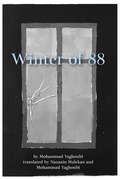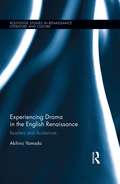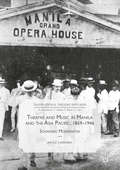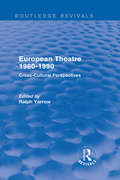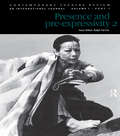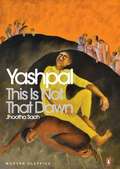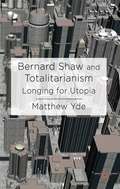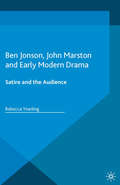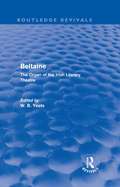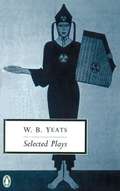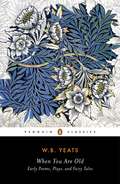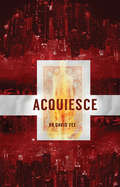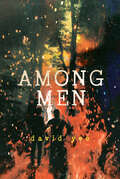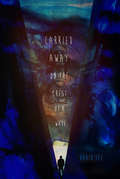- Table View
- List View
The Country Wife: A Comedy, As It Is Acted At The Theatre-royal. Written By Mr. Wycherley
by William WycherleyOriginally performed and published in 1675, this five-act play parodies the vices and hypocrisies of Restoration London. The plot centers on the eponymous country wife, Margery, whose suspicious husband, Mr. Pinchwife, keeps her isolated. On a rare outing to the theater, Margery encounters the aptly named Mr. Horner. A notorious rake who feigns impotence to trick his way into the intimate company of married ladies, Horner soon schools Margery in the art of deception and realizes Pinchwife's worst fears. Bursting with racy dialog and bawdy humor, this comic masterpiece offers an enduring blend of cynicism, satire, and farce. The elegance of the play's construction and the glamour of its setting provide a piquant contrast to its earthy celebration of lust and human folly. The Country Wife has been periodically vilified for its immorality but remains ever popular for its lively characters, witty double entendres, and sophisticated drama.
Four Great Restoration Comedies (Dover Thrift Editions Ser.)
by William WycherleyWhen England's theaters reopened in 1660, 18 years after being closed by an act of Parliament, audiences embraced the witty and satirical dialogue spoken by "plain folks" characters--it was a new era in drama. The four comedy classics featured in this one convenient collection are typical of the works popularized during one of the most exciting and innovative periods in English theater.Brimming with bawdy and satirical comedies and rampant with notorious womanizers, amorous adventure, and marital discord are works by William Wycherley (The Country Wife), Sir George Etherege (The Man of Mode), Aphra Behn (The Rover), and Sir John Vanbrugh (The Relapse).
Towards a Cultural Philology: "Phedre" and the Construction of 'Racine'
by Amy Wygant"Amy Wygant reads Racine's ""Phedre"" (1677) through an analysis of its 17th-century cultural contexts and a consideration of its subsequent reception history. She explores the construction of Racinian language as ""musical"", the poetics of the Racinian gaze, and Racine's labyrinthine eros of memory and forgetting. Reference is made to Lully's operas, the battle between the advocates of colour and the champions of drawing in the Royal Academy of Painting and Sculpture, and Le Notre's centreless garden labyrinth at Versailles. These close textual and contextual studies relate the detail of the tragedy to the conceptual sweep of 17th-century absolutism. Wygant's interdisciplinary study draws on the music history, as well as on emblematics, the history of the formal garden and the arts of memory. Racine's great threnody, the ""recit de Theramene"", is shown as representative of expressions of loss which lie at the root of early modern literature."
Bram Stoker, Dracula and the Victorian Gothic Stage
by Catherine WynneBram Stoker worked in the theatre for most of his adult life, as theatre reviewer in Dublin in the 1870s and as business manager at London's Royal Lyceum Theatre in the final two decades of the 19th century. Despite this, critical attention to the influence of the stage on Stoker's writing has been sparse. Bram Stoker, Dracula and the Victorian Gothic Stage addresses this lacuna, examining how Stoker's fictions respond to and engage with Victorian theatre's melodramatic climate and, in particular, to supernatural plays, Gothic melodramas and Shakespearean productions that Henry Irving and Ellen Terry performed at the Lyceum. Bram Stoker, Dracula and the Victorian Gothic Stage locates the writer between stage and page. It reconsiders his literary relationships with key actors, and challenges the biographical assumption that Henry Irving provided the model for the figure of Count Dracula.
Choreographing Intersubjectivity in Performance Art (New World Choreographies)
by Victoria Wynne-JonesThis book offers new ways of thinking about dance-related artworks that have taken place in galleries, museums and biennales over the past two decades as part of the choreographic turn. It focuses on the concept of intersubjectivity and theorises about what happens when subjects meet within a performance artwork. The resulting relations are crucial to instances of performance art in which embodied subjects engage as spectators, participants and performers in orchestrated art events. Choreographing Intersubjectivity in Performance Art deploys a multi-disciplinary approach across dance choreography and evolving manifestations of performance art. An innovative, overarching concept of choreography sustains the idea that intersubjectivity evolves through places, spaces, performance and spectatorship. Drawing upon international examples, the book introduces readers to performance art from the South Pacific and the complexities of de-colonising choreography. Artists Tino Sehgal, Xavier Le Roy, Jordan Wolfson, Alicia Frankovich and Shigeyuki Kihara are discussed.
Peony Pavilion: Mudan Ting
by Tang Xianzu Cyril BirchThe Peony Pavilion is one of literature's most memorable love stories and a masterpiece of Ming drama.
The Peony Pavilion: Mudan Ting
by Tang Xianzu Cyril Birch Catherine Crutchfield Swatek Xianzu TangThe celebrated English translation of this classic work of Chinese literature is now available in an updated paperback edition. Written in 1598 by Tang Xianzu, The Peony Pavilion is one of literature's most memorable love stories and a masterpiece of Ming drama. Cyril Birch has captured all the elegance, lyricism, and subtle, earthy humor of this panoramic tale of romance and Chinese society. When Indiana University Press first published the text in 1981, it seemed doubtful that the work would ever be performed in its entirety again, but several spectacular and controversial productions have toured the world in recent years. For this second edition, which contains a fully revised text of the translation, Cyril Birch and Catherine Swatek reflect on contemporary performances of the play in light of its history.
Where Is Broadway? (Where Is?)
by Douglas Yacka Francesco Sedita Who HQTake your seats, because Where Is Broadway? is ready to take center stage!In a lively and engaging style, authors Douglas Yacka and Francesco Sedita cover the development of the first theaters and the birth of the American musical, as well as the shows and stars that have become Broadway legends. Readers will get the inside story on their favorite shows and may even discover some new ones.
Touring Theatrical Productions: An International Guide
by Dinesh YadavTouring Theatrical Productions: An International Guide is a practical and comprehensive overview of planning, staging and closing international touring productions. This book offers a step-by-step chronological journal of preparing a company for international touring, from applying for international visas to returning home after a tour. It includes discussions of invitations, contracts, scheduling, health and safety, personnel, packing and shipping, certifications, insurance, travel, unions, hotels, ethics and cuisines. Each chapter is filled with guidelines, samples of paperwork and checklists to ensure the smooth running of any international tour. Written by the Production Manager and Technical Director of India’s most travelled show The Manganiyar Seduction with Can & Abel Theatres, this book includes examples, incidents and experiences of performing in over 20 countries with over 200 shows. This how-to guide will benefit Technical Directors and Production Managers of touring productions, as well as students in Production Management, Tour Management, Art Administration and Technical Theater courses.
Winter of 88
by Mohammad YaghoubiThe events of this play are based on the author’s real experiences during the Iran–Iraq War.The play premiered in Farsi in 1997 in Tehran.The book will be published in both English and Farsi.First produced in English at the Next Stage Theatre Festival, Toronto, in January 2020
Experiencing Drama in the English Renaissance: Readers and Audiences (Routledge Studies in Renaissance Literature and Culture)
by Akihiro YamadaThis book investigates the complex interactions, through experiencing drama, of readers and audiences in the English Renaissance. Around 1500 an absolute majority of population was illiterate. Henry VIII’s religious reformation changed this cultural structure of society. ‘The Act for the Advancement of True Religion’ of 1543, which prohibited the people belonging to the lower classes of society as well as women from reading the Bible, rather suggests that there already existed a number of these folks actively engaged in reading. The Act did not ban the works of Chaucer and Gower and stories of men’s lives – good reading for them. The successive sovereigns’ educational policies also contributed to rising literacy. This trend was speeded up by London’s growing population which invited the rise of commercial playhouses since 1567. Every citizen saw on average about seven performances every year: that is, about three per cent of London’s population saw a performance a day. From 1586 onwards merchants’ appearance in best-seller literature began to increase while stage representation of reading/writing scenes also increased and stimulated audiences towards reading. This was spurred by standardisation of the printing format of playbooks in the early 1580s and play-minded readers went to playbooks, eventually to create a class of playbook readers. Late in the 1590s, at last, playbooks matched with prose writings in ratio to all publications. Parts I and II of this book discuss these topics in numerical terms as much as possible and Part III discusses some monumental characteristics of contemporary readers of Chapman, Ford, Marston and Shakespeare.
Theatre and Music in Manila and the Asia Pacific, 1869-1946: Sounding Modernities (Transnational Theatre Histories)
by MeLê YamomoThis book examines the intersection between sound and modernity in dramatic and musical performance in Manila and the Asia-Pacific between 1869 and 1948. During this period, tolerant political regimes resulted in the globalization of capitalist relations and the improvement of transcontinental travel and worldwide communication. This allowed modern modes of theatre and music consumption to instigate the uniformization of cultural products and processes, while simultaneously fragmenting societies into distinct identities, institutions, and nascent nation-states.Taking the performing bodies of migrant musicians as the locus of sound, this book argues that the global movement of acoustic modernities was replicated and diversified through its multiple subjectivities within empire, nation, and individual agencies. It traces the arrival of European travelling music and theatre companies in Asia which re-casted listening into an act of modern cultural consumption, and follows the migration of Manila musicians as they engaged in the modernization project of the neighboring Asian cities.
European Theatre 1960-1990: Cross-Cultural Perspectives (Routledge Revivals)
by Ralph YarrowEuropean theatre has been the site of enormous change and struggle since 1960. There have been radical shifts in the nature and understanding of performance, fuelled by increasing cross-cultural and international influence. Theatre has had to fight for its very existence, adapting its methods of operation to survive. European Theatre 1960-1990, first published in 1992, tells that story. The contributors - who in many cases have been theatre practitioners as well as critics - provide a wealth of fascinating information, covering Germany, France, Poland, Italy, Spain and Sweden, as well as Britain. The book offers an historical and descriptive overview of developments across national boundaries, enabling the reader to compare and contrast acting and directing styles, administrative strategies and the relationship between ideology and achievement. Chapters trace the evolution of theatre in all its aspects, including such elements as the end of censorship in many countries, the upsurge in political and personal awareness of the 1960s, shifting patterns of state artistic policy, and the effects on companies, directors, performers and audiences. This book should be of interest to undergraduates, postgraduates and academics of theatre studies.
Jana Sanskriti (Routledge Performance Practitioners #24)
by Ralph YarrowRegarded by Augusto Boal as the international icon of his vision, Jana Sanskriti are the leading practitioners of Theatre of the Oppressed and Forum Theatre in India and the East. The group has worked continuously with rural communities in West Bengal since its beginnings in 1985 to reconfigure social and political relationships through theatre, achieving both a solid regional presence and an international reputation. This book combines: a biography of the group, charting their history, methodology and modes of operation an examination of Jana Sanskriti through the writings of their founder, Sanjoy Ganguly a detailed analysis of their performance events and practices, including the plays collected in Ganguly's Where We Stand (2009) practical exercises and games, taken from Jana Sanskriti's workshops and festivals. As a first step towards critical understanding, and as an initial exploration before going on to further, primary research, Routledge Performance Practitioners offer unbeatable value for today’s student.
Presence and Pre-Expressivity 2
by Ralph YarrowThis is Volume 7, Part I of the Contemporary Theatre Review, an International Journal, with this edition focusing on Prescence and pre-expressivity. Covering topics such as Body in Mind: Exploring Pre-Expressivity; Peter Brook and Traditional Thought; Grotowski, Holiness, and the Pre-Expressive; Barba's Concepts of the Pre-Expressive and the Third Organ of the Body of the Theatre and Theories of Consciousness; Pre-Expressivity: Some Thoughts from the Rehearsal Floor.
This Is Not That Dawn Jhootha Sach
by Yashpal Translated from the Hindi AnandJhootha Sach is arguably the most outstanding piece of Hindi literature written about the Partition. Reviving life in Lahore as it was before 1947, the book opens on a nostalgic note, with vivid descriptions of the people that lived in the city’s streets and lanes like Bhola Pandhe Ki Gali. Tara, who wanted an education above marriage; Puri, whose ideology and principles often came in the way of his impoverished circumstances; Asad, who was ready to sacrifice his love for the sake of communal harmony. Their lives—and those of other memorable characters—are forever altered as the carnage that ensues on the eve of Independence shatters the beauty and peace of the land, killing millions of Hindus and Muslims, and forcing others to leave their homes forever. Published in English translation for the first time, Yashpal’s controversial novel is a politically charged, powerful tale of human suffering.
Bernard Shaw and Totalitarianism Longing for Utopia
by Matthew YdeThis book reveals the genuity of Shaw's totalitarianism by looking at his material - articles, speeches, letters, etc but is especially concerned with analyzing the utopian desire that runs through so many of Shaw's plays; looking at his political and eugenic utopianism as expressed in his drama and comparing this to his political totalitarianism.
Ben Jonson, John Marston and Early Modern Drama: Satire and the Audience
by Rebecca YearlingThis book examines the influence of John Marston, typically seen as a minor figure among early modern dramatists, on his colleague Ben Jonson. While Marston is usually famed more for his very public rivalry with Jonson than for the quality of his plays, this book argues that such a view of Marston seriously underestimates his importance to the theatre of his time. In it, the author contends that Marston's plays represent an experiment in a new kind of satiric drama, with origins in the humanist tradition of serio ludere. His works—deliberately unpredictable, inconsistent and metatheatrical—subvert theatrical conventions and provide confusingly multiple perspectives on the action, forcing their spectators to engage actively with the drama and the moral dilemmas that it presents. The book argues that Marston's work thus anticipates and perhaps influenced the mid-period work of Ben Jonson, in plays such as Sejanus, Volpone and The Alchemist.
Beltaine: The Organ of the Irish Literary Theatre (Routledge Revivals)
by W. B. YeatsFirst published in 1970, this book is a faithful representation of the original edition of Beltaine, a literary magazine edited by W. B. Yeats from May 1899 to April 1900. Beltaine was the first of several magazines of the Irish Literary Theatre (later to become The Abbey Theatre) in which Yeats’s editorial role was of utmost importance. It was an occasional publication and focused on promoting current works of Irish playwrights whilst challenging those of their English opponents. The magazine mainly consists of a series of essays on the theatre in Dublin, and supplementing these are explanations and discussions of new plays, excerpts from which are often included. This book will be of interest to those with an interest in Yeats, early nineteenth-century literature, and Irish theatre.
Selected Plays (Penguin Modern Classics)
by William YeatsThe 18 plays are: The Shadowy Waters; Cathleen in Houlihan; The Hour Glass; On Baile's Strabd; The Green Helmet; Deirdre; At the Hawk's Well; The Dreaming of the Bones; The Cat and the Moon; The Only Jealousy of Emer; Calvary; Sophocles' King Oedipus; The Resurrection; The Words Upon the Windwo-FPane; The King of the Great Clock Tower; The herne's Egg; Purgatory; The Death of Cuchulain.
When You Are Old: Early Poems, Plays, and Fairy Tales
by William Butler Yeats Rob DoggettRecalling Yeats's 1890s fascination in aestheticism and the arts and crafts movement, selections will draw from the first published versions of poems from works such as Crossways, The Rose, The Wind Among the Reeds, In the Seven Woods, The Green Helmet and Other Poems, Responsibilities, The Wild Swans at Coole, and Michael Robartes and the Dancer. A selection Irish myths and fairytales including "The Wanderings of Oisin," a Celtic fable and his first major poem, represent his fascination with mysticism, spiritualism and the rich and imaginative heritage of his native land.
acquiesce
by David YeePlagued by the success of his first book and haunted by his past, Sin Hwang arrives in Hong Kong with some unusual cargo and a lot of emotional baggage. Featuring a surreal cast of characters, from a foul-mouthed Paddington Bear to a wisecracking Buddhist monk, this sharply comedic and heartbreakingly poignant tale of self, familial, and spiritual discovery reflects the cycles from which we must all break free as we find our way.
among men
by David YeeDavid was inspired to write this after reading Al Purdy’s poem “House Guest,” the only poem that really records this period of Al Purdy and Milton Acorn’s lives.First produced by Factory Theatre, Toronto, in April 2022
carried away on the crest of a wave
by David YeeFrom the shore of Ko Phi Phi in Thailand to a suburb in Utah to a mysterious Kafkaesque hole in the ground, carried away on the crest of a wave gives us brief glimpses into the lives of a sphinx-like escort, a grieving father, a conflicted priest, brothers of legend, a felonious housewife, an accountant of time, an orphaned boy, a radio shock jock and a man who finds things. Each are connected, primarily, by the cataclysmic 2004 Indian Ocean tsunami that claimed the lives of over a quarter million people. In a series of vignettes, carried away on the crest of a wave illustrates the ripple effect of one of the deadliest natural disasters in recorded history and ponders what happens when the events that bind us together are the same events that tear us apart.
